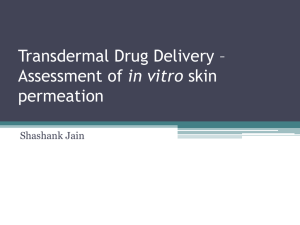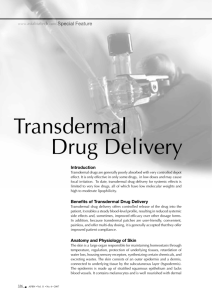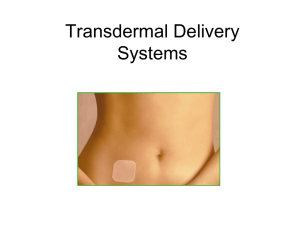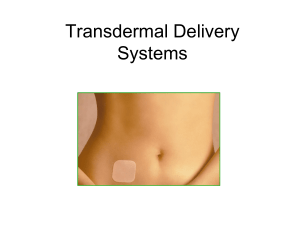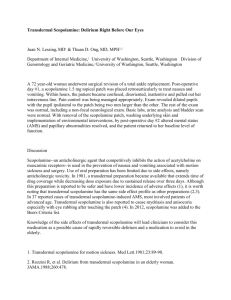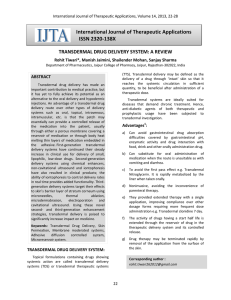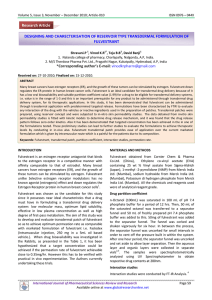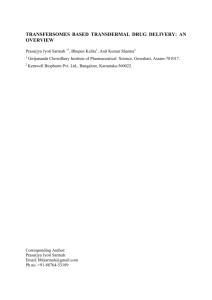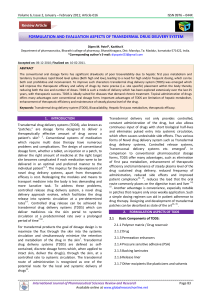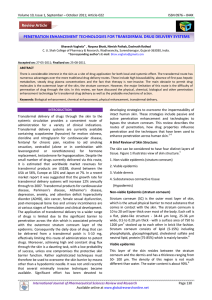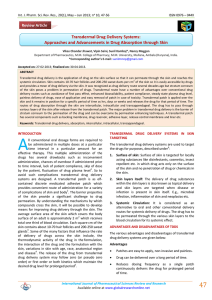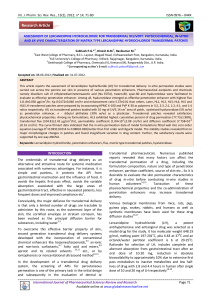Transdermal drug delivery
advertisement
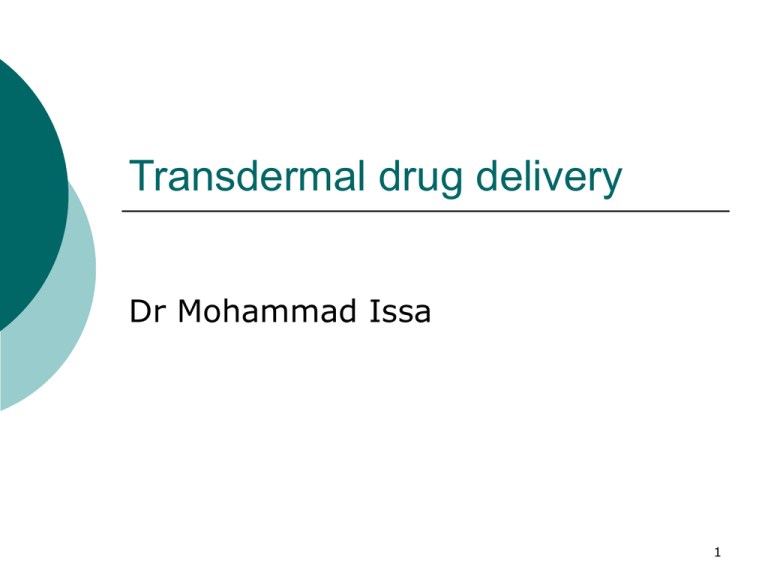
Transdermal drug delivery Dr Mohammad Issa 1 Anatomy and Physiology The site of administration of both topical and transdermal delivery systems is the skin surface The skin is the largest single organ in the human body It serves a number of critical functions: protection from pathogens and chemicals, act as a sensor to inform the brain of changes in the surroundings It is divided into three layers: the epidermis, the dermis, and the subcutaneous (fat) layer 2 Anatomy and Physiology The uppermost layer of the skin is the epidermis. The thickness of the epidermis varies over the body, and is roughly 0.05 mm on the eyelids and 1.5 mm on the palms and soles of the feet The outermost portion of the epidermis, the stratum corneum, serves mainly as a waterproof barrier. This layer, which is 10 to 15 um thick, consists of dead, flattened cells embedded in a lipid bilayer. These cells are composed of tough, fibrous protein called keratin and are being continuously replaced by newer cells that migrate upward 3 Anatomy and Physiology The dermis is a thick layer that consists of connective tissue and is responsible for the strength and flexibility of the skin The dermis contains nerve endings, sweat glands, hair follicles, and blood vessels The drug molecule that diffuse across the epithelium are distributed systemically because of the presence of a rich vascular network in the dermis Below the dermis is the subcutaneoous (fat) layer. This layer helps to regulate body temperature and also provides a protective padding 4 Anatomy and Physiology The fat layer varies in thickness across the body. Some lipophilic drugs accumulate in the adipose tissue, and this decrease the plasma concentration of these drugs 5 Anatomy and Physiology 6 Conventional formulations for transdermal drug delivery The formulations used for transdermal drug delivery include ointments, creams, and gels Nitroglycerin, testosterone, estrogen and progesterone are delivered systemically as ointments and gels These Formulations are relatively inexpensive and easy to manufacture They are associated with less local skin reactions than with patches 7 Conventional formulations for transdermal drug delivery Variability and poor reproducibility in the amount of drug delivered result primarily from improper application technique, application of too little or too much of the product, and removal of the product from the site of application by its rubbing off on clothes and other surfaces before all the drug is absorbed Another major concern is that the product may be transferred from the individual who is being treated to another individual through direct skin contact 8 Transdermal Delivery Systems The first transdermal therapeutic system (TTS) which contained scopolamine to prevent nausea and vomiting associated with motion sickness, was approved in 1981 The two major types of TTS products are: matrix system reservoir system 9 Transdermal Delivery Systems: Matrix System Matrix systems are also referred to as monolithic System The simplest type of matrix system is the three-layer system 10 Transdermal Delivery Systems: Matrix System The first layer is the backing film that helps provide the integrity of the drug Layer and keep it occluded and protected during storage and use In the second Layer the drug and other excipients are uniformly distributed in an adhesive polymer. The adhesive polymer (or a combination of two or more adhesive polymers) serves as both a means by which the device is held to the skin and the vehicle for the drug 11 Transdermal Delivery Systems: Matrix System The last layer consists of a protective liner that is peeled off and discarded by the patient before the patch is applied. It helps protect the drug layer during transport and storage of the patch Some matrix systems may be more complex, with the drug dispersed in a polymer, and the adhesive layer comprising a separate layer. Matrix systems can hold a large quantity of drug, which is often in excess of the amount that is delivered during the use of the patch. 12 Transdermal Delivery Systems: Matrix System The rate of drug release is controlled by the polymeric matrix and also by the stratum corneum The drug is dispersed in a solid polymeric matrix, and thus the integrity of the system is generally maintained even if the system is cut and there is less potential for dose dumping as a result of intentional tampering or unintentional damage to the system Matrix systems are thinner than reservoir systems and hence may be easier to use 13 Transdermal Delivery Systems: Reservoir System In these systems, the active ingredient is in a solution or suspension located between the backing layer and a rate-controlling membrane A reservoir system typically consists of five layers 14 Transdermal Delivery Systems: Reservoir System The first layer is the backing film The second layer is the reservoir that includes the drug and excipients. Excipients may include a solvent that helps dissolve or disperse the drug, a polymer that acts as a gelling agent, and surfactants that help maintain the drug in solution. The solvents and surfactants can also enhance the percutaneous absorption of the drug The third layer is a semipermeable membrane that is made of polymers such as polyethylene, polypropylene, or ethylene vinyl acetate 15 Transdermal Delivery Systems: Reservoir System The semipermeable membrane regulates the rate at which the drug diffuses from the reservoir The adhesive layer is the fourth layer. A small quantity of drug may also be included in the adhesive layer; for example. in Catapres TTS®, which is a transdermal system providing continuous systemic delivery clonidine for 7 days, the drug in the adhesive layer is released immediately, which helps build the initial drug levels in the skin The last layer is the protective layer or protective liner 16 Transdermal Delivery Systems: Reservoir System The integrity of the system is not maintained if the system is cut, and significant potential exists for dose dumping if intentional tampering or unintentional damage to the system occurs. 17 Components of a Transdermal Therapeutic System Backing layer Adhesives Penetration Enhancement 18 Components of a Transdermal Therapeutic System: Backing layer The backing layer is the outermost layer of the TTS It primarily helps maintain the integrity of the system and protects the product during its period of use and throughout its shelf life. The backing film must be occlusive, because this helps keep the skin hydrated by retaining moisture in the skin and thus improves permeation Transparent, pigmented, or aluminized films of polymers such as polyethylene, polyurethane, or polyester are used as backing liners 19 Components of a Transdermal Therapeutic System: Adhesives Because a TTS must stay in contact with the skin for the required period of time, the adhesive and its appropriate selection are crucial to the functioning of being used in transdermal products, and very often these compounds are combined These compounds adhere to the skin by application of light force and do not Leave a residue when the system is removed Adhesives should also exhibit substantial strength of adhesion and duration of adhesion and should not cause any skin irritation or sensitization 20 Components of a Transdermal Therapeutic System: Adhesives The patch should be easy to remove from the skin without causing pain In many matrix types of TTSs, the adhesive and the drug are mixed together. In such cases, the solubility of the drug in the adhesive and the impact of the adhesive on the diffusion coefficient of the drug must be studied thoroughly The compatibility of the adhesive with the drug and other excipients must be carefully examined 21 Components of a Transdermal Therapeutic System: Penetration Enhancement Most substances cannot permeate the skin at sufficient rates to produce therapeutic concentrations This is due primarily to the barrier properties of the stratum corneum Occlusion increases the hydration of the stratum corneum by inhibiting water loss from the skin. Increasing skin hydration can increase the permeation of some compounds, and it thus acts as a natural penetration enhancer. 22 Components of a Transdermal Therapeutic System: Penetration Enhancement A number of chemical compounds have been identified as penetration enhancers (also called permeation enhancers, sorption promoters, or accelerants) to improve the permeation of drugs through skin These include surfactants (eg. sorbitan monooleate), fatty acids and esters (eg, oleic acid), and solvents (eg. alcohol and propylene glycol)) A penetration enhancer acts by reducing the barrier resistance of the stratum corneum without damaging the cells and may also improve the solubility of the diffusing drug within the skin 23 Components of a Transdermal Therapeutic System: Penetration Enhancement These compounds thus allow drug molecules to cross the straturn corneum at a faster rate. Ideally, they should also improve drug solubility and stability in the formulation. Many of these penetration enhancers cause dermal irritation. Ethanol is a permeation enhancer that has been used in a number of formulations. 24 Active Transdermal Drug Delivery These delivery systems use energy to increase the rate and extent of drug movement across the skin One advantage of these methods is that drug penetration does not depend on the concentration gradient to force the drug molecule across the skin and therefore molecules that are charged or hydrophilic can also be delivered via these methods 25 Active Transdermal Drug Delivery 1. Iontophoresis 2. Phonophoresis (or Sonophoresis) 3. Electroporation 4. Microneedle- or Micro projection- Based Devices 26 Iontophoresis 27 Iontophoresis Iontophoresis involves application of a low intensity electric current to facilitate the permeation of a drug into the skin. Iontophoresis can increase the rate of transdermal penetration of hydrophilic compounds. A solution containing ionized drug is placed into contact with an electrode of the same charge as that of the ions. These ions are thus repelled by the electrode. This forces the ions into the skin. 28 Iontophoresis A return electrode of the opposite charge in contact with a second reservoir helps complete the electrical circuit The charge and concentration of the ion, the surface area of the delivery electrode, and the intensity and duration of current influence the amount of drug that penetrates the skin. Only a low level of current can be used to force the drug, because this reduces the chances of skin irritation or sensitization. 29 Iontophoresis: examples The LidoSiteTM Topical System delivers lidocaine and epinephrine topically by iontophoresis: lidooine is a local anesthetic, and epinephrine, because of its vasoconstrictor properties, helps to maintain anesthesia by decreasing the rate of removal of the drug from the site. Another system that has been approved by the FDA is IonsysTM (fentanyl iontophoretic transdermal system). Ionsys is a patientactivated transdermal system that is used to deliver Fentanyl into the systemic circulation. 30 LidoSiteTM Topical System 31 Phonophoresis (or Sonophoresis) In phonophoresis (or sonophoresis) energy from low frequency ultrasonic waves is used to enhance drug absorption. The method increases drug permeation through temporary disruption of the barrier layer as a result of cavitation Cavitation causes the enlargement of intercellular spaces. The increase in the temperature of the skin surface caused by sound waves enhances permeation of drug. 32 Electroporation In electroporation, high-voltage pulses are applied to the skin for a short period. This increases the permeability of the stratum corneum to the drug being administered. This increase in permeation is thought to result from the formation of pores, which usually close within a very short time after the removal of the pulse 33 Microneedle- or Micro projectionBased Devices In microneedle- or microprojection-based devices, tiny drug-coated projections or needles are used to pierce the top layer of skin and make superficial holes through which the drug can be transported into the skin The projections are too small to penetrate into the dermis and hence do not reach the nerve endings The Macro- flux® system by Alza Corporation uses this principle 34 Microneedle- or Micro projectionBased Devices 35 36
